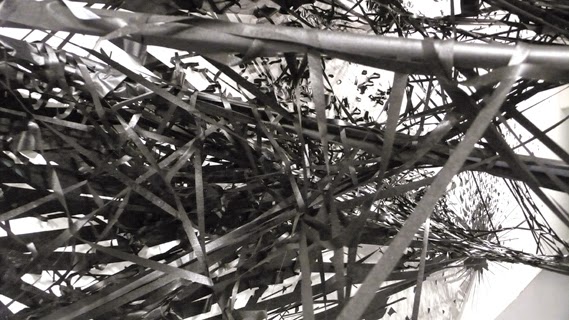Looking at his surroundings, Bradford looks through the many layers of discarded papers to find recycled memories. He explores the many different layers of living in the black community. He picks and scrapes the signs off the walls and gates. Those collections of papers are his resource materials to create large colleges that take on the look of large scale paintings. Bradford is proud to say he entered the art world through the doors of his mother’s beauty salon. He attributes making her salon signs as the first steps in becoming a “MAKER”, not just an artist. Starting out, Bradford said he had no idea about abstract-expressionism? Or who Bell Hooks or Cornell West were? Grad school was were he discovered artists through reading, writing, theory, and art practice. Although grad school has a heavy work load and tests the strength of artist it is a great foundation and door to walk through to the world of art makers. The balance is and can be accomplished. Mark Bradford has achieved it. - Retrieved from this link
Monday, 16 March 2015
Mark Bradford (1961 - )
Britta Lumer (1965 - )
Lumer's use of ink and water is particularly ghostly and quite dysgraphic. Her work is also quite textural, with the brush strokes visible.
Robin Rhode (1976 - )
Wardell Milan (1978 - )
Milan is a prime example of dysgraphic representation of the figure. He subtly uses charcoal and gouache, getting interesting textures and tonal variation. Note his minimal use of line and how he largely blocks in the form with bold strokes.
From this link
From this link
From this link
From this link
From this link
Monika Grzymala (1970 - )
Grzymala makes three dimensional drawings using electrical tape stuck to the walls of the gallery space. The tape looks similar to crosshatching or line drawings. There is definitely tonal variation. There is an energy visible in the "drawings", maybe having something to do with how the tape is stretched tautly across the space.
From this link
From this link
From this link
From this link
From this link
What experimental materials can you use to make art?
- Toothbrush
- Shoes
- Knitting/ sewing/ crocheting
- Wire
- Blue tack
- Foam/ cardboard
- Tape
- Sticks/ brooms
- Light
- Ribbons
- String/ thread
Today's class - dysgraphia part 3
Warm up drawings
Warm up drawings
Warm up drawings
Warm up drawing
Warm up drawing - blind contour drawing
In this drawing, we had to study the pose for about 10 seconds then close our eyes and draw what we remembered. Tricky because as soon as I shut my eyes I forgot how the model was posing!
This was a series of poses drawn to capture the movement of the poses.
Covered the whole sheet in charcoal (accidentally conte) and then drew with an eraser, mapping the highlights seen in the pose.
I think this drawing is quite successful. This was drawn from a 20 min pose, focusing on the key word deskilling. I used various deskilling techniques, such as drawing without looking at the paper and continuous line.
In this drawing I focused on dysgraphia/ deskilling, drawing with continuous line without looking at the paper and then coming back in and erasing/ smudging the model's form. Not sure how good looking the drawing is but I think it is quite successful in exploring the theme of dysgraphia/ deskilling.
In this drawing I was looking at distortion. With blind contour, I drew the form first landscape then flipped the page into portrait.
Subscribe to:
Comments (Atom)



































